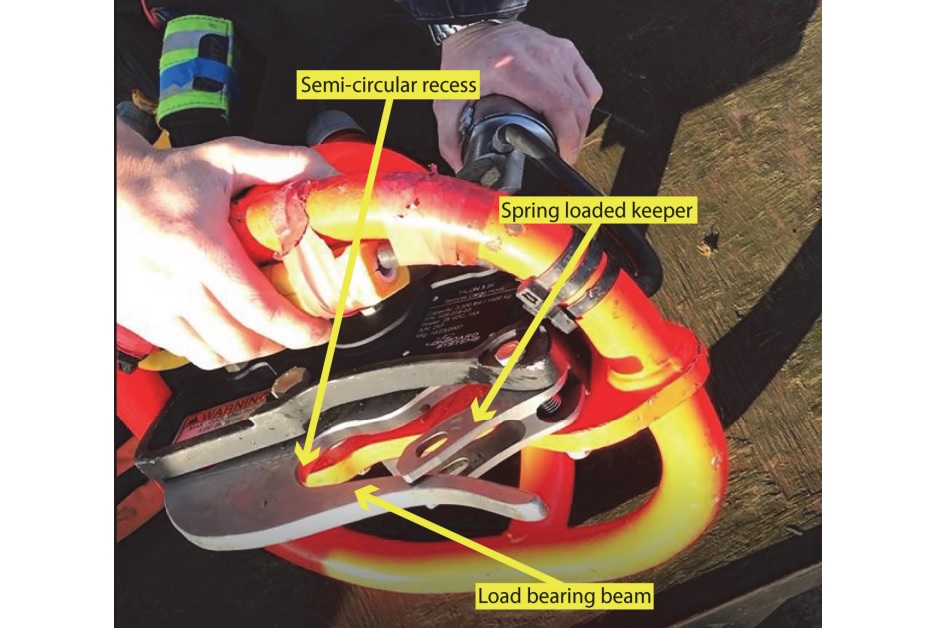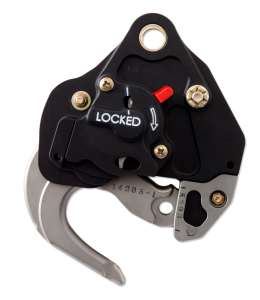HESLO AS350B2 Dropped Load – Phase Out of Spring-Loaded Keepers for Keeperless Hooks (PDG AS350B2 G-PDGF)
On 3 March 2020 Airbus Helicopters AS350B2 G-PDGF of PDG Aviation Services inadvertently dropped a 700 kg underslung load while conducting Helicopter External Sling Load Operations (HESLO) near Glencoe in Argyll, Scotland. The pole broke into two when it impacted a hillside about 200 m from a minor public road, but clear of any third parties.
HESLO AS350B2 Dropped Load – The Incident Flight
G-PDGF was being used to transport 47 wooden poles over 2 days to work sites alongside an electricity powerline which was being refurbished. Prior to starting the task the pilot of met the ground handler, who also worked for the operator, and three client employees. The UK Air Accidents Investigation Branch (AAIB) explain in their safety investigation report (issued 9 July 2020) that:
The client’s employees had previously attended a training course on helicopter operations, which covered lifting underslung loads. The ground handler briefed the employee who would be hooking on the loads at the storage facility. The ground handler’s task was to assist and oversee this operation but also to refuel the aircraft at a separate refuel site. This meant that, whilst the ground handler was at the refuelling site, the client’s employee would be left unsupervised to ‘hook on’ the loads.
During the afternoon of day one, after successfully transporting several loads…G-PDGF arrived to pick up a 700 kg pole whilst the ground handler was away from the storage facility. The pilot manoeuvred the helicopter to allow the client’s employee to attach the load to the hook. The design of the hook consists of a load bearing beam which, when electrically actuated by the pilot, causes the beam to rotate around a pivot allowing the load to be released before then re-closing.
Once the load was attached the pilot climbed G-PDGF to lift the pole off the ground. He transitioned to forwards flight whilst…cross-referencing the engine instruments and checking the load in a mirror as he increased airspeed in 10 kt increments. He stabilised the helicopter at 60 kt and 200 ft agl, as opposed to his usual transit speed of 80 kt, for the short flight to the work site.
However, after about 6 km the pole began to develop a spinning motion, which rapidly increased in intensity, and which the pilot could feel through the airframe. Immediately, he lowered the collective and applied rear cyclic to bring G-PDGF rapidly to the hover but, before he could complete this manoeuvre, the pole fell from the helicopter. The pilot immediately returned G-PDGF to the refuel site and shutdown. He inspected the undamaged hook, which was found in the closed position, and the strop that was later recovered from the hillside was also undamaged.
The Operator’s Analysis
Four causes for the loads release were considered by the operator’s safety investigation:
- the inadvertent release of the electrically-operated hook by the pilot;
- the release of the hook due to an electrical malfunction; and
- two causes, similar in nature, that could cause the spring-loaded keeper to be forced open during flight.
The operator considered it unlikely that the load was released inadvertently by the experienced pilot because the release system requires two independent switches on the cyclic to be depressed simultaneously to command a release. The hook and its release system were electrically checked by the operator’s engineering department and no faults were found; however, an intermittent fault could not be ruled out as an alternative cause for the inadvertent release of the load.
The operator considered the most likely cause was that, when the load was hooked on at the storage facility, the sling carrying the load was not positioned fully into the semi-circular recess on the load bearing beam which normally provides additional protection against any movement of the sling. This would have allowed the sling to move during flight and, as the load spun rapidly, to overcome the resistance of the spring-loaded keeper thereby releasing the load.
AAIB Conclusion
The most probable cause for the inadvertent release of the load was that the load had not been positioned correctly across the hook’s load bearing beam when the load was hooked on. At this time, the client’s employee, although having been trained in underslung load lifting operations, was working alone and was not being directly supervised. However, an intermittent fault could not be ruled out as an alternative cause for the release.
Safety Action – Phase Out of Spring-Loaded Keepers for Keeperless Hooks
The operator is continuing to phase out the use of hooks with spring-loaded keepers in favour of using keeperless hooks for most of its operations. Additionally, the operator has amended its procedures so that, if spring-loaded keeper hooks are used, only the operator’s employees will carry out loading operations.
However, crucially:
The operator advised that, as keeperless hooks require the use of two hands, it will retain a few spring-loaded keeper hooks for tasks such as lifting a load from a scree-covered hillside, where using both hands poses a greater risk to the loader.
Keeperless Cargo Hooks
The AAIB don’t mention what type or make of keeperless hook is to be used, but here we illustrate Onboard Systems TALON LC Keeperless Hook:
While using remote hooks with a traditional keeper has distinct advantages for missions requiring fast loading, it comes with strict rigging size limitations and requires at least 2 lb. (1 kg) of weight on the load beam to release. For missions where rapid loading isn’t an issue, or that require unique linkage (such as United States Forest Service (USFS) or the Department of the Interior (DOI) contract-provided equipment), or where greatest load safety is paramount, a keeperless configuration would be a better option.
To eliminate the risk that a load ring could escape by slipping past the keeper during operation, we simply removed the keeper and replaced it with a unique load beam system that stays open after the load is jettisoned. Closing is accomplished by pushing upward on the load beam with the rigging.
Safety Resources
- Load Lost Due to Misrigged Under Slung Load Control Cable
- Keep Your Eyes on the Hook! Underslung External Load Safety
- EC120 Underslung Load Accident 26 September 2013 – Report
- Unexpected Load: AS350B3 USL / External Cargo Accident in Norway
- Unexpected Load: B407 USL / External Cargo Accident in PNG
- Load Lost Due to Misrigged Under Slung Load Control Cable
- Fallacy of ‘Training Out’ Error: Japanese AS332L1 Dropped Load
- Helicopter External Sling Load Operation Occurrences in New Zealand
- Maintenance Issues in Fire-Fighting S-61A Accident
- UPDATE 26 July 2020: Impromptu Landing – Unseen Cable
- UPDATE 8 August 2020: Inadvertent Entry into IMC During Mountaintop HESLO
- UPDATE 7 September 2020: Shocking Accident: Two Workers Electrocuted During HESLO
- UPDATE 31 October 2020: Loss of Control During HESLO Construction Task: BEA Highlight Wellbeing / Personal Readiness
- UPDATE 24 April 2021: Unballasted Sling Stings Speedy Squirrel (HESLO in France)
- UPDATE 18 March 2023: HESLO AS350 Fatal Accident Positioning with an Unloaded Long Line
- UPDATE 5 August 2023: A Concrete Case of Commercial Pressure: Fatal Swiss HESLO Accident
Also:
- The UK AAIB has reported on a fatal accident to AS350B2 G-PLMH during HESLO with a boat at Loch Scadavay, Western Isles, Scotland, 13 June 2018.
- The Flight Safety Foundation (FSF) run Helicopter External Load Operations for Ground Personnel training.
- See also UK CAA CAP 426 – Helicopter External Load Operations.
- CASA issued Airworthiness Bulletin 25-006 “to notify operators and maintainers of additional safety information and current design standards for cargo hooks installed in helicopters”. It discusses phenomena such as Dynamic Rollout (or Ring Reversal), Jammed Loads / Hooks, Uncommanded Release / Inadvertent Cargo Hook Opening etc.
- UPDATE 25 July 2020: The US Navy suffered a more expensive dropped load when a Sikorsky MH-60S Knighthawk assigned to Helicopter Sea Combat Squadron 2 (HCS2) made an ‘unintentional jettison’ of a $2 million Raytheon AN/AQS-235 Airborne Mine Neutralization pod near the entrance to the Chesapeake Bay, off the coast of Virginia on 9 July 2020.
- UPDATE 8 September 2020: The Japan Transport Safety Board (JTSB) are investigating a 28 August 2020 HESLO incident near Nagaoka involving AS332L1 JA332T of Tohoku Air Service were 790 kg construction materials were dropped from 25 m.
- UPDATE 6 July 2021: Interagency Aviation Safety Alert IASA 21-02 was issued on 26 April 2021 on the topic of Preventing Remote Hook Inadvertent Release.




Recent Comments